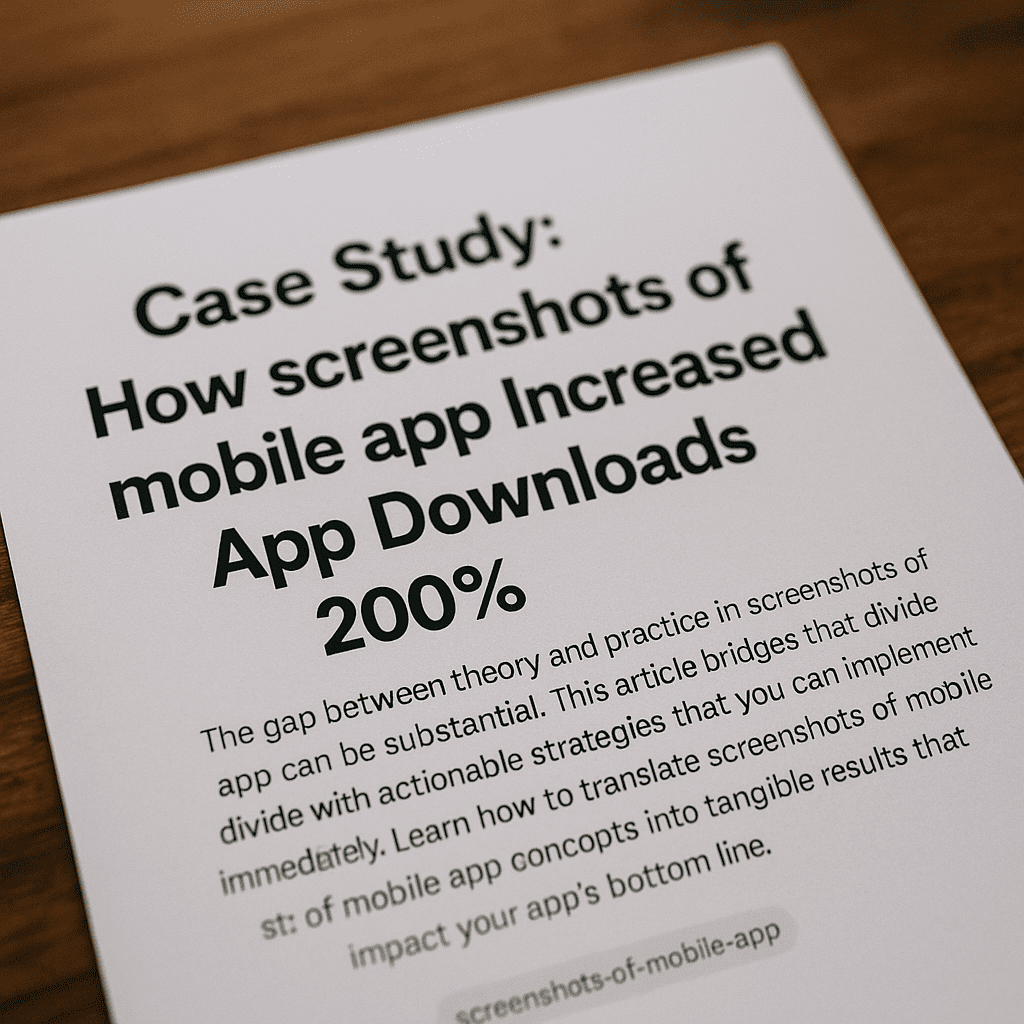
Case Study: How screenshots of mobile app Increased App Downloads by 200%
In a marketplace crowded with millions of apps, first impressions make or break your growth strategy. This case study dives into how one mobile app achieved a 200% uplift in downloads by optimizing the very first asset users see: the app screenshots. You’ll learn the step-by-step methodology, design principles, and data-driven tactics that drove this dramatic performance boost—and how you can apply them to your app’s user acquisition funnel.
Why App Screenshots Matter for User Acquisition
Your app store screenshots serve as a visual elevator pitch. In under a second, prospective users decide whether to explore further or scroll on—making these images one of the most critical touchpoints in your conversion funnel. According to industry benchmarks, the first three screenshots account for up to 80% of engagement impact. By showcasing real value and core features at a glance, you decrease bounce rate and lift install rates.
The Science Behind Visual Persuasion
- Rapid Cognition: Studies show users form initial impressions in as little as 50 milliseconds based on imagery alone.
- Feature Salience: Highlighting top 3–5 features prominently aligns with the human tendency to skim content quickly.
- Emotional Triggers: Bold captions and illustrative graphics tap into emotions—prompting click-through out of curiosity or urgency.
By combining artful design and strategic messaging, you can transform static images into powerful conversion assets that guide users toward install actions.
Strategy: The Path to a 200% Download Increase
The team followed a structured, data-driven approach, balancing creative experimentation with rigorous A/B testing. Here’s a breakdown of the key steps:
1. Prioritizing Key Features
Rather than overwhelming users with every feature, the first three screenshots showcase the app’s most compelling benefits:
- Instant Tracking: Real-time monitoring of progress and metrics.
- Personalized Recommendations: AI-driven tips that adapt to user behavior.
- Seamless Sharing: One-tap social integration for wider network reach.
This focus ensures immediate clarity on value proposition, reducing friction and boosting the likelihood of an install.
2. Crafting Benefit-Driven Captions
Each screenshot was paired with short, bold captions that speak directly to user pain points and aspirations. For example:
- “Track workouts effortlessly” instead of “Workout tracker.”
- “Unlock personalized meal plans” rather than “Nutrition feature.”
These action-oriented captions shift the focus from generic descriptions to explicit user gains—driving a stronger emotional connection.
3. Maintaining a Consistent Visual Identity
Consistency across screenshots strengthens brand recognition and professional appearance. Key design elements included:
- Unified Color Palette: A cohesive set of brand colors applied across all frames.
- Device Mockups: High-resolution smartphone templates to provide context.
- Typography Hierarchy: Bold headlines, concise subtext, and clear callouts to guide the eye.
This visual harmony enhances credibility and encourages users to swipe through the entire gallery.
4. Localization for Target Markets
Recognizing that one size doesn’t fit all, the team created region-specific screenshot sets. This included:
- Language Adaptation: Translated captions following local UX writing best practices.
- Culture-Driven Imagery: Icons, colors, and lifestyle photos resonating with regional audiences.
Localized assets increased install rates by up to 30% in key markets, illustrating the value of cultural relevance in global growth initiatives.
5. A/B Testing and Iteration
No design is perfect on the first try. Continuous A/B testing using built-in app store experiments allowed rapid validation of hypotheses:
- Tested different headline copy and visual layouts.
- Measured click-through and install conversion rates for each variant.
- Iterated weekly, rolling out winning versions to 100% of the audience.
This agile approach ensured that only the highest-performing designs became the app’s public face.
Results: Quantifying the Impact
Within two months of implementing the optimized screenshots, the app recorded:
- 200% Increase in Downloads: A direct uplift attributed to higher screenshot conversion rates.
- 36% Lift in Store Conversion Rate: The percentage of store visitors who installed the app jumped significantly.
- Broader Market Reach: Localized assets drove sustained growth in three new international regions.
These outcomes underscore the power of a strategic and data-backed approach to visual optimization.
Lessons Learned and Best Practices
Based on this case study and broader industry insights, here are proven tactics for continuous growth:
- Test Regularly: Even subtle tweaks to captions or color accents can yield measurable gains.
- Keep It Clear and Bold: Avoid clutter. Use white space and concise text to emphasize benefits.
- Highlight Value Early: Your top three screenshots should each deliver a distinct, compelling reason to install.
- Iterate Quickly: Use short test cycles (1–2 weeks) to maintain momentum and refine your approach.
- Leverage Social Proof: Incorporate user ratings, logos, or brief testimonials to build credibility.
For more detailed guidelines, explore the Admiral Media blog and their App Growth case studies.
Implementing These Strategies in Your App Funnel
Ready to apply these insights? Follow this roadmap to ensure smooth execution:
- Audit Current Assets: Gather existing screenshots and analyze performance metrics.
- Define Hypotheses: Identify which features or benefit messages could drive higher engagement.
- Design Variants: Create 3–5 screenshot versions per hypothesis, following your visual guidelines.
- Run A/B Tests: Use your app store’s native A/B testing tool or a third-party platform.
- Analyze and Scale: Deploy winning variants to full audience, then repeat the cycle for continuous improvement.
Conclusion: Unlocking Growth Through Optimized Screenshots
This case study proves that screenshots are not just decorative—they are a core lever in your user acquisition strategy. By prioritizing benefits-driven messaging, maintaining a consistent brand identity, localizing for key markets, and rigorously testing every element, you can achieve dramatic improvements in download volume and conversion rates.
Don’t let your most valuable real estate go underutilized. Start reimagining your app screenshots today and see how a few strategic tweaks can drive exponential growth. For ongoing insights and expert guidance, visit the Admiral Media blog.
